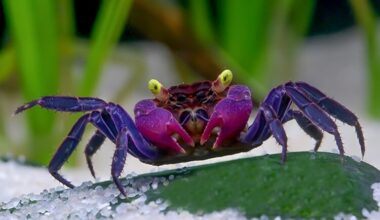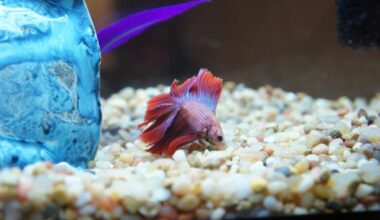Bladder snails are interesting tank inhabitants that have a mixed reputation (depending on who you ask). Some view them as pests that need to be removed, and others view them as helpful aquarium cleaners!
No matter what category you fall into, understanding the core needs of this species will allow you to take the necessary course of action to reach your desired outcome. This guide will teach you everything you need to know.
Table of Contents
Species Summary
Bladder snails (Physa acuta) are an abundant mollusk species that often shows up in freshwater tanks unannounced. They’re considered an invasive species and are usually deemed pests by the fish-keeping community at large! These critters can hitchhike on plants and spread eggs prolifically, resulting in rapid population spikes that can quickly overtake a tank!

Despite the bad reputation, bladder snails can actually be a welcome addition to your fish tank in controlled numbers (if you want). They can function as an effective part of the aquarium’s cleaning crew and will spend most of their time grazing on waste and different types of algae (more on that later).
Whether you introduced them to your tank intentionally or not, learning about this snail (and what it needs) can help you take full advantage of the benefits they provide.
Appearance
These snails might be widespread, but that doesn’t make them any less visually appealing.
Bladder snails have thin and translucent shells. They are slightly yellow in color and may feature some distinct markings of gold. You can see the snail’s flesh through the snail. Usually, it’s gray with splashes of black or purple.
The mantle, which forms the outer wall of the snail’s body, is a little more colorful. It has bright yellow-orange spots.
As a whole, the shell has a pretty interesting shape. It’s more egg-like in form and features a defined tip. Four to five whorls create the signature spiral, which moves to the left.
Peeking out from under the shell are thread-like tentacles. The sensory tentacles hold the eyes, which are small black spots.
The Difference Between Bladder Snail & Pond Snails
Many people mistake the bladder snail for garden-variety pond snails. It’s easy to confuse the two, as they can easily cohabitate in the same environment. Bladder snails appear on every continent in the world except for Antarctica. In fact, these snails have spread so much that zoologists don’t know where they originated from!
While they look similar, closer inspection shows some glaring differences.
The first difference is the size. Pond snails anywhere from two to six times larger than the bladder snail.
Furthermore, the shell is different. On pond snails, the cover is opaque and brown. For bladder snails, it’s translucent and yellowish. Even the shape is unique.
Author Note: Bladder snails are sinistral. This means that the shell spirals to the left, which is pretty rare in the mollusk world. Most species, including the pond snail, are dextral and have armor that twists to the right. Furthermore, bladder snails don’t have the operculum lid that most snails use for protection.
The last notable difference is the tentacles. Pond snails have thick triangular tentacles instead of the thin thread-like ones of the bladder snail.
Lifespan
In the right living conditions, the average bladder snail lifespan is usually no longer than two years. Of course, they can succumb to illness much earlier. There are no guarantees when it comes to life expectancy.
Author Note: That said, the state of their environment has a significant impact on the snail’s longevity. Generally, dirtier aquariums offer more feeding opportunities for bladder snails. As a result, they tend to live longer and breed more often (more on that later).
Average Size
The average bladder snail size is half an inch. If they’re lucky, some specimens can reach lengths of 0.6 inches.
These are small mollusks that don’t take up a ton of room. However, don’t make the mistake of thinking that they won’t have an impact on bioload. Larger populations can have just as much impact as bigger fish!
Bladder Snail Care
Bladder snails are resilient little critters! They don’t take much to flourish in your aquarium. For most aquarists, the goal is to eradicate these invertebrates instead of supporting them!
We chose to write this from the perspective of bladder snail care, but this information will also work for aquarists who want to get rid of the.
Whatever your goals may be, understanding the basic needs of the bladder snail will allow you to reach your desired outcome!
Tank Size
When it comes to tank size, bladder snails have no preferences. They can survive in tiny one-gallon tanks and massive ponds! Thanks to their small size, they’re pretty adaptable regardless.
Keep in mind that every living thing you add to an aquarium will have a bioload that impacts the water conditions. Bladder snails are no different.
If you want to keep these snails for cleaning and maintenance purposes, it’s better to house them in a larger tank to decrease the influence they have.
Water Parameters
There are no hard and fast rules for the bladder snail. This species is super adaptable and can live in a wide range of conditions. In the wild, they can even live in sewage plants!
Generally, these snails prefer to live in warm waters with little to no flow. But for the most part, they are undemanding. As a result, you can focus on the other creatures in your aquarium instead of the snails. Just stick to the following parameters to ensure the snails’ survival.
- Water temperature: 64°F to 84°F
- pH levels: 7.0 to 8.0
- Water hardness: 12 to 18 dGH (harder water)
Calcium
When they’re born, bladder snails have very soft shells. Almost immediately, they’ll seek out some calcium to toughen up their armor.
Author Note: A decent amount of calcium in the water is essential for snail survival. Without it, this species tends to suffer from stunted growth and limited reproduction rates. You can use that fact to your advantage if you’re trying to manage an out-of-control population.
But if you want the snails to live healthy, consider adding some crushed eggshells or cuttlefish bones.
What To Put In Their Tank
Once again, bladder snails aren’t picky (you’re probably noticing a pattern here).
This species is a little unique compared to most other snails in the trade. For one, they are pulmonary snails that breathe air.
They have a unique respiratory system that allows them to float, bob, and swim in the water as they see fit. They can eliminate the air in their respiratory system to sink to the bottom or use it to shake off unwanted parasites and bugs.
You won’t see them digging through sand like other snails. They might hide within the decor and cover themselves with a soft substrate, but they don’t infiltrate the tank bottom. For this reason, they don’t even have preferences between sand or gravel!
The same goes for plants. They prefer to have plants to climb and hide. They also enjoy feeding on decaying plant matter. However, they don’t touch healthy plants or feed on thriving vegetation.
Author Note: If you want the population to increase, give the snails plenty of natural food sources. That means plants that will decay over time, driftwood to accumulate algae, and more. Other than that, however, the decor is up to you!
Common Possible Diseases
Diseases aren’t something that too many aquarists worry about when it comes to bladder snails.
Technically speaking, they can succumb to all the same illnesses as any other freshwater mollusk. The most common ailments your snails might encounter are fungal and bacterial infections. Severe cases can cause some significant damage to the shell.
Even parasites are possible. However, those tend to be rare with bladder snails. As mentioned earlier, they can shake worms and microorganisms off their bodies if they feel an infestation.
Like any other fish or invert, the key to avoiding disease is to maintain tank conditions. Check the water parameters regularly and make any necessary changes to prevent noticeable fluctuations. Also, perform quarterly water changes every couple of weeks to keep ammonia and nitrate levels low.
Food & Diet
Bladder snails have an appetite that just won’t quit! They’re constantly eating! Not only that, but they’ll consume pretty much anything they can get their little mouths on.
Omnivores through and through, bladder snails eat everything from algae to decaying meat or insects. In an aquarium setting, they tend to function as algae-eaters for the bulk of their diet. However, they’ll also consume leftover food, decaying waste, and so much more.
There are a lot of great food sources in an aquarium. It’s the perfect environment for these snails as far as food goes!
Author Note: However, keep in mind that too much food availability can lead to some trouble. Growing snail populations are a telltale sign that you’re going overboard with fish food! Try to limit waste and decaying items to ensure that the number of snails in your freshwater aquarium stays manageable.
Behavior & Temperament
Bladder snails are a “fly under the radar” kind of tank inhabitant. Many don’t even realize they have snails until many months after they’re introduced to the tank. Thanks to their small size, they can easily stay out of sight.
Throughout the day, scavenging and foraging is their primary focus!
These snails are on a perpetual search for food. Once they find it, they tend to stick to the same area until they deplete it.
Author Note: You might see the snails “swimming” through the water from time to time. That’s completely normal and is usually the snail using their air bladder to escape trouble.
When they’re not trying to get away from would-be predators, bladder snails spend their days crawling on plants, the glass walls of the tank, and more. They don’t dig like other snail species. Interestingly enough, they can also move pretty fast!
Tank Mates
Talking about tank mates for bladder snails is different from talking about mates for other inverts and fish.
Bladder snails can coexist with just about any freshwater creature. However, the best course of action is to house them with natural predators. Doing so controls the snail population and ensures that you never have an out-of-control infestation to deal with.
So while this might not seem like a traditional “tank mate” scenario, it’s the common course of action for most aquarists. Bladder snails act as feeders for:
- Assassin Snails
- Crayfish
- Yoyo Loaches
- Betta Fish
- Green Spotted Puffer
Breeding
You won’t have a problem getting bladder snails to breed. They do so naturally without any intervention whatsoever. These snails spawn very quickly and can easily overwhelm a tank.
Bladder snails are hermaphroditic, which means that they have both male and female reproductive organs. As a result, these snails can reproduce in one of two ways.
If they don’t have an available mate around, they can propagate and self-fertilize internally. This usually occurs when the snail’s survival is at risk. However, it’s not ideal as the offspring aren’t as strong as traditional spawning methods.
When two or more snails are together, they can reproduce as expected.
The snails will lay small egg capsules that contain anywhere between 10 and 40 eggs. They tend to apply them under plant leaves and on inconspicuous surfaces. It only takes about a week for the eggs to hatch.
Bladder snails reach maturity in as little as a month, so it doesn’t take long for the population to boom!
Conclusion
Whether you’re interested in bladder snail care or removal, having a strong understanding of this species is absolutely necessary if you’re an aquarist.
We hope you found this guide helpful and feel prepared to handle these critters in your freshwater tank. If you have any questions feel free to send them over!

